
|
|
(chronologically, by film title) Intro | Summary Chart | Silents-1949 | 1950 -1966 | 1967-1969 | 1970-1974 | 1975-1977 | 1978-1979 1980 | 1981 | 1982 | 1983-1984 | 1985-1986 | 1987-1989 1990-1991 | 1992-1994 | 1995 - 1 | 1995 - 2 | 1996-1997 | 1998 | 1999 | 2000 | 2001 - 1 | 2001 - 2 2002 - 1 | 2002 - 2 | 2002 - 3 | 2003 | 2004 | 2005 | 2006 | 2007-2011 | 2012-2014 | 2015-2017 | 2018-2019 | 2020-2021 |
|
| Film Title, Director, Studio, Budget Information, Description | |
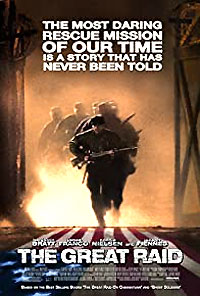
|
The Great Raid (2005) Director: John Dahl Studio/Distributor: Miramax Budget: $80 million Domestic Gross: $10.2 million Worldwide Gross: $10.8 million Total Net Loss: $75 million Total Estimated Loss (Inflation-Adjusted): $104 million |
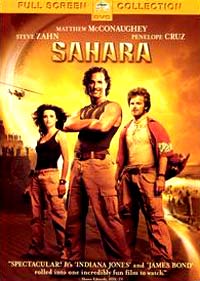
|
Sahara (2005) This summer action film was hotly anticipated, with its sexy male star Matthew McConaughey (as Dirk Pitt) opposite the always-alluring but miscast Penelope Cruz, in the first (and last) of a potentially-lucrative "Indiana-Jones" like adventure series of films. Its tagline hopefully declared: "Dirk Pitt. Adventure has a new name." First-time feature film director Breck Eisner (son of then-Disney chairman Michael Eisner) valiantly tried to instill this absurd film with light tones, but ended up with a very mediocre action film - with lots of close calls lacking any suspense or tension. A frivolous plot, out-of-place pop-song soundtrack, and plodding pace were only a few of its problems. The enormous flop suffered from exorbitant production and marketing costs that inevitably dwarfed its revenue intake. Its muddled production was the result of its 20 producers and 4 credited screenwriters (although ten scripters were paid almost $4 million in fees and bonuses). And major expenditures were made for salaries and 'star perks' for the two stars. The tabloids were heated up over the one-year affair between Spanish actress Cruz (post-Tom Cruise) and hunky Texan McConaughey that began when they met during filming. It was popular with the Teen Choice Awards, with nominations for Choice Movie Actor and Actress: Action/Adventure/Thriller (McConaughey and Cruz), and Choice Movie Liplock between the couple. The story told about two ex-Navy SEALS, hard-drinking adventurer-explorer and Civil War-buff Dirk Pitt (McConaughey) and Italian buddy Al Giordino (Steve Zahn) in war-torn modern-day Africa searching for treasure on a sunken iron-clad Confederate warship that supposedly sank off the coast in 1866, but now inexplicably could be found under the Saharan desert. They were joined by pretty, humanitarian WHO doctor Eva Rojas (Cruz) while she was searching for the cause of an outbreak of a mysterious illness in the region. The trio was assaulted by African military dictator General Kazim (Lennie James) and evil, multinational corporate criminal Yves Massarde (Lambert Wilson), exhibited by lots of chases, a series of gun battles, explosions, and a high body count. The author of "Sahara" (the eleventh of his eighteen Pitt best sellers), Clive Cussler, filed a highly-publicized and expensive (for all sides) lawsuit in 2004 against Paramount Studios after rejecting script drafts. He sought $115 million in damages for not being granted "absolute approval" and creative control over the film's script before shooting commenced. In May 2007, the long, drawn-out 14-week case finally ended - a court declared that Cussler had to pay the film's production company Crusader Entertainment $5 million, presumably for sabotaging the film's profitability by making derogatory comments to the public about the film and encouraging his readers to boycott it. Simultaneously, Crusader was ordered to pay Cussler about $8.5 million for second-picture rights to another of his books that he had sold to the company. More scandal surfaced when it was reported that a 46-second plane crash sequence that cost $2 million was excised from the final print, and when it was also revealed that "courtesy payments," "gratuities" and "local bribes" totaling $200K were passed out in Morocco, where much of the movie was filmed. |
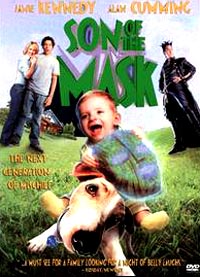
|
Son of the Mask (2005) Jamie Kennedy took over for Jim Carrey (as Stanley Ipkiss), who declined to appear in this feeble remake-sequel to the original comedy-fantasy hit The Mask (1994). Living in the town of Fridge City, Kennedy took the role of aspiring animation cartoonist Tim Avery (homage to legendary Warners' animator Tex Avery), aka The Mask. As in the first film, donning the magical ancient mask played shape-shifting havoc on the workaholic's home life with pretty baby-crazed wife Tonya (Traylor Howard) and their Jack Russell terrier Otis -- and it was worn on the night that their baby son Alvey (Liam and Ryan Falconer) was conceived. The strange green mask summoned the mischievous spirit of Norse god Loki (Alan Cumming), causing all kinds of problems. To create further comic conflict, supreme Norse god of war Odin (Bob Hoskins) was furious and had ordered his son Loki to repossess the mask - Loki then donned various unfunny disguises to pursue the baby, born with cartoon-like abilities. Although the camerawork, the creative CGI, and the art/production design were impressive, the looney and frantic antics of the film outweighed their sensory, visceral benefits. It was decisively criticized as being a failure on all counts, attested to by its eight Razzie nominations (the most nominations of any 2005 film): Worst Picture, Worst Actor (Jamie Kennedy), Worst Supporting Actor (Alan Cumming and Bob Hoskins), Worst Director (Lawrence Guterman), Worst Screenplay (Lance Khazei), Worst Screen Couple (Jamie Kennedy and Traylor Howard), with one win for Worst Remake or Sequel. |
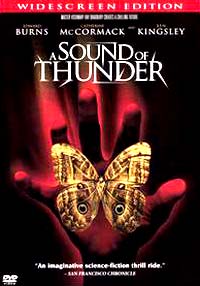
|
A Sound of Thunder (2005) This catastrophic, science-fiction time-travel film from Peter Hyams, based partly on a 1952 cautionary short story by Ray Bradbury, was originally to be released in 2003, but circumstances (including severe flooding in its shooting location of Prague in the Czech Republic, and bankruptcy of the original production company Franchise Pictures) delayed its release until 2005. The long-delayed story told about exploitative, white-haired founder Charles Hatton (Ben Kingsley) of the time-travel agency named Time Safari Inc., and his hired scientist and tour leader Dr. Travis Ryer (Edward Burns), who led weathy adventurers on Jurassic Park-like excursions from futuristic Chicago of 2055 to an era millions of years ago when Allosaurus dinosaurs roamed the Earth and could be hunted by wealthy clients, shooting non-evasive nitrogen bullets at prey that would die anyway. There were only a few simple rules that weren't to be broken by the time-traveling tourists: don't take or leave anything, and don't stray off the virtual pathway. The film's suspense developed when one time traveler squashed a butterfly, and time-machine designer/technologist Dr. Sonia Rand (Catherine McCormack) was forced to race back into the past before a cataclysmic, time-rippling chain reaction upset the course of evolution and Earth was dramatically changed. Life was already being upset, however -- the primordial growth of plantlife, and then the arrival of giant mutated bats, piranha-faced anaconda-like eels, swarms of carnivorous beetle-bugs, and a pack of carnivorous baboona-saurs cross-breeds - and massive subway flooding. Ironically, the film opened at the same time as the Katrina hurricane disaster in New Orleans. It was soundly criticized for its cheesy and artificial-looking special effects (with obvious blue/green screens), poor acting, undeveloped characters, pseudo-scientific talk, uneven exposition and pacing, a non-sensical script that defied rationalization, and evidence of last-minute editing. |
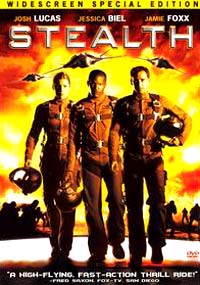
|
Stealth (2005) This big-budget, noisy futuristic action thriller from director Rob Cohen, with the cautionary tagline about technological warfare: "Fear the Sky," told the story of three elite Navy fighter jet pilots: Lt. Ben Gannon (Josh Lucas), Lt. Henry Purcell (recent Oscar-winner Jamie Foxx), and Lt. Kara Wade (Jessica Biel) who were testing an experimental, ultra-high-tech prototype fighter plane called the Talon on aircraft carrier USS Abraham Lincoln in the Philippine Sea. A fourth flier was added to their squad by their commanding officer Captain George Cummings (Sam Shepard), although they were unaware that it was an unmanned, 'perfect' aircraft with artificial intelligence (a UCAV for Unmanned Combat Aerial Vehicle) code-named "EDI" for Extreme Deep Invader (voice of Wentworth Miller). When the EDI (or "Eddie") was struck by lightning during a storm and began acting independently like HAL 9000 in Stanley Kubrick's 2001: A Space Odyssey (1968), trouble loomed in the form of various predictable plot elements, such as a government conspiracy, and a global crisis. This lifeless but glossy film with a preposterous plot (weak sci-fi premise), one-dimensional characters (except for EDI), and inane dialogue was a combinational retread of various flyer films, such as Top Gun (1986) (with loud aerial combat fight sequences resembling a video game, although Ben declared: "I just don't think war should become a videogame"), Iron Eagle II (1988), Wargames (1983) with its computer simulations, Short Circuit (1986), the Terminator's Skynet, and as mentioned the similar rogue computer in 2001: A Space Odyssey (1968). One of the film's few gratuitous highlights was the sight of Jessica Biel in an eye-catching blue bikini while on R&R in Thailand, and another incredulous extended scene of her ejecting from her exploding plane wearing a parachute while being threatened by flaming debris and shrapnel as she fell toward enemy soil (North Korea). This late-summer release was a big flop for Sony Pictures, in a year when it also had other disasters, such as Lords of Dogtown (2005) about teen skateboarding, and the remake of the 1960s TV show Bewitched (2005) with Nicole Kidman. The only bright spot about the film was that it became the first movie to be combined with a video game when it was released in the Sony PlayStation Portable's UMD format. |
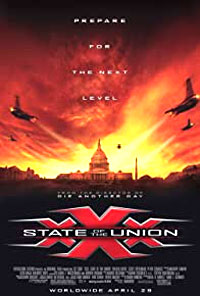
|
xXx: State of the Union (2005) Director: Lee Tamahori Studio/Distributor: Columbia Pictures Budget: $113.1 million Domestic Gross: $26.9 million Worldwide Gross: $71 million Total Net Loss: $78 million Total Estimated Loss (Inflation-Adjusted): $108 million |